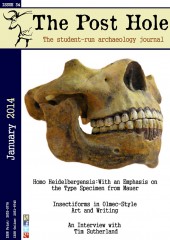The article in review is published in the Journal of Island & Coastal Archaeology (2006), 1: pp.67-99.
The impact of the environment upon early states has long been a subject of archaeological research, but Kennett and Kennett's work aims to readdress a perceived imbalance in the discussion of southern Mesopotamian state formation. They argue that other scholars have overlooked environmental changes and have also evaluated the archaeological record in context of an environment that was static or assumes a present day environment, (Kennett and Kennett 2006, 67). However, they fail to include almost any mention of Northern Mesopotamia to provide as a comparison, or to discuss whether climatic change in the north caused possible migration; instead, it focuses on sea level and sediment changes in the Gulf. They argue that it seems peculiar that climate change has long been accepted as a major factor of societal collapse, (Weiss et. al. 1993), yet its role in the formation of such societies is barely discussed. They formulate such argument regarding the past climatic state of Mesopotamia using "newly available paleo-environmental records for the region", (Kennett and Kennett 2006, 67). The strengths and weaknesses of such data and their overall argument is discussed in part in this review.
The article itself is subdivided in a standard fashion: an abstract, which has been broadly summarised above, followed by an introduction that outlines the existing scholarship regarding the formation of early states in Southern Mesopotamia from c.3300BC onwards, itself followed by the extensive assimilation of data of "postglacial environmental change in Southern Mesopotamia", (Kennett and Kennett 2006, 69), covering data for the last 15,000 years. This is followed by a section discussing "state development in Southern Mesopotamia", (Kennett and Kennett 2006, 79), which centres on the available archaeological evidence from c.6000BC, giving a broad chronological account from the Ubaid Period to the Late Uruk Period. Finally, the two sections of data are brought together in the discussion portion as the article explores the relationship between climate change and societal developments before drawing the conclusion that "global eustatic (sea level movement from glacial freeze and thaw) and climate changes influenced dynamic environmental conditions in Southern Mesopotamia, along with inter-related changes in human demography, economy and socio-political organisation", (Kennett and Kennett 2006, 90).
The introductory section of the article is a good summary of each of the variety of theories regarding state formation in southern Mesopotamia, giving a multitude of references to build a comprehensive background on the issues in existing scholarship. This is useful, but the content of this section itself adds very little and is arguably an elongated reference list. Kennett & Kennett (2006) stress that all factors require consideration in the context of the environmental changes, and that greater credence be given to the idea that climate change caused states to form, not simply collapse. They also disregard the study by Lees & Falcon (1952) which stated that sediment deposition was counterbalanced by tectonic shifts causing slightly higher sea levels; this study is supported by both Pollock (1999) and McIntosh (2005), highlighting confusion with regard to ancient sea levels in the Gulf. This section builds upon the abstract and expands their methodology with regard to the use of paleo-environmental data but is unspecific at this point with no sites or particular methods discussed at this stage. Kennett & Kennett (2006) criticise other scholars for assuming that the environment had been unchanged in Southern Mesopotamia throughout the Holocene; in particular, they reference the work of Susan Pollock (1992) as an example of apparent naivety to assume that the environment remained unchanged. This assumption that the climate and environment is the same in the modern day as that of the time of early state formation is something that needs addressing; Kennett and Kennett's (2006) work is useful in this argument but it seems that this issue is one of slightly older scholarship of pre-2000. Pollock (1992, 305) states that "there is no evidence to suggest that these basic (environmental) features were significantly different then from now" but does clarify that much of the past environment at the time was little understood. However, in Pollock's (1999, 34) work of Ancient Mesopotamia, she now asserts that the "physical environment is never stable… the climate has changed and the natural vegetation has profoundly altered".
This reflects the possible effect that techniques such as paleo-environmental analysis and remote sensing have given an understanding of environmental changes and how ancient Mesopotamia may have looked, specifically river movements (Hritz 2010). It would have been prudent for Kennett and Kennett (2006) to include Pollock's (1999) later assessment of climate change in Mesopotamia as it would have improved their argument regarding the reliability and plausibility of the paleo-environmental data as a previous sceptic now accepts significant climate change in Ancient Mesopotamia. They could also have included how modern day discussions of anthropomorphic climatic change and research in the late 1990s have altered certain scholars’ opinions.
The section concerning paleo-environmental data is extensive and, as one would expect, the terminology used is highly scientific and I personally struggled to understand some of the language with little to no definitions provided for technical terms. This paper assumes prior knowledge of such studies and processes. For someone who has never studied these processes in depth, it is difficult to assess and comment on the conclusions from the analyses of paleo-environmental data. There are numerous charts and graphs provided in this section; these are effective in allowing the reader to assess the text in pictorial form, but even then some figures are still harder to understand and interpret, for example Figures 5 and 6, (Kennett and Kennett 2006, 75, 77). The provenance of the data itself should be scrutinised, but this is not just a negative reflection upon the article itself, more a cautionary note to the use of such data in general. One example is the study of Soreq Cave which has been mostly led by the work of Bar-Matthews (1997; 2011), who has repeatedly sampled the site for speleothems to analyse and plot the possible ancient climate with peaks and troughs of rainfall and aridity that has been linked with sea levels. In the earlier 1997 study, Table 1 (Bar-Matthews 1997, 160) demonstrates the ranged variability of the data in terms of how accurate the dating of the speleothems was. Samples thought to be 4500 years old had a range +/- 600-900 years for error, so samples could have been anything from 5400 to 3600 years old. How can assumptions regarding a direct relationship between climate change and cultural changes be made with a possible 1800 year variation on the samples? Generally, the evidence for climate change in Mesopotamia is limited; Soreq Cave in Israel is one of the few sites that provide an unbroken record for the last 25,000 years and is therefore relied upon for many reconstructions of the ancient climate (Bar-Matthews 1997). Whilst being part of the same broad weather system, as Mesopotamia is not in the region itself, it is a singular example and therefore there is little-to-no comparative evidence to challenge it with. By Bar-Matthews’ (1997; 2011) own admission, the data of the cave relies on continuity between the isotope levels and climate for the past 25,000 years which is in no way guaranteed. In my opinion, Kennett and Kennett's (2006) article does not expand upon the discrepancies of the data enough and discuss the possible flaws with it.
Wossink (2009), challenged the assumption that because climate change and social change occurred contemporaneously it signifies a cause-and-effect relationship, and noted that scholars fail to identify archaeological evidence for definitive correlation. In this article, the section summarising the relationship between climate and social change deals in general hypotheses that lack definitive archaeological support. This is not a criticism of only Kennett and Kennett (2006); with the whole field study of climate and environmental change, the data set is still limited. Admittedly, the error range in the Soreq Cave study has been dramatically reduced since the fresh 2011 study by Bar-Matthews to +/- 20-100 years in some cases, which could obviously not have been included in this article as it predates such research. But there is still not enough direct evidence for the climatic changes in Mesopotamia and even less of its definitive impact upon human settlement. Modern studies using remote sensing and fresh analyses of a wider range of data samples more directly relevant to Mesopotamia may in the future provide a more complete picture of early state formation, but they are not included in this study.
Kennett & Kennett's "Early State Formation in Southern Mesopotamia: Sea Levels, Shorelines and Climate Change", despite only being composed in 2006, is arguably an article of its time. It attempts to rectify the apparent oversight regarding climatic change and its impact upon state formation, and undoubtedly their general argument that climate played a significant role in early state formation is surely likely. However, often they fail to use direct archaeological evidence and instead rely upon chronological correlation, and the data with regards to the environment is not scrutinised to a high enough degree and effectively presented at face value. The exclusion of Northern Mesopotamia and a study of its climatic differences, which may have affected state formation, arguably weakens their work. This article is suitable for someone with some experience with the arguments regarding state formation and environmental changes both past and present, but the nature of its argument must be considered carefully. The subject would certainly benefit from a reassessment and evaluation with the modern techniques of remote sensing and survey; it is subject to wider problems in the archaeological and environmental records, yet fails to recognise this, to its detriment.
Bibliography
- Bar-Matthews, M., Ayalon A., and Kaufman, A., (1997) "Late Quaternary paleoclimate in the Eastern Mediterranean Region from stable isotope analysis of speleothems at Soreq Cave, Israel", Quaternary Research, 47, 155–168.
- Bar-Matthews, M & Ayalon, A, (2011) "Mid-Holocene climate variations revealed by high-resolution speleothem records from Soreq Cave, Israel and their correlation with cultural changes", The Holocene, 21, 163-171.
- Hritz, C., (2010) "Tracing settlement patterns and channel systems in southern Mesopotamia using remote sensing", Journal of Field Archaeology, 35 (2), 184–203.
- McIntosh, J.R, (2005) Ancient Mesopotamia: New Perspectives, Oxford Press, Oxford.
- Lees, G. M. and Falcon N. L.. (1952) The geographical history of the Mesopotamian plains. The Geographical Journal, 118, 24–39.
- Pollock, S. (1992) "Bureaucrats and managers, peasants and pastoralists, imperialists and traders: Research on the Uruk and Jemdet Nasr periods in Mesopotamia", Journal of World Prehistory, 6, 297–336.
- Pollock, S. (1999) Ancient Mesopotamia: The Eden That Never Was. Cambridge: Cambridge University Press.
- Weiss, H., M.-A. Courty, W. Wetterstrom, F.Guichard, L. Senior, R. Meadow, and A.Curnow. (1993) "The genesis and collapse of Third Millennium North Mesopotamian civilization" Science, 261, 995–1004.
- Wossink, A, (2009) Challenging climate change: Competition and cooperation among pastoralists and agriculturalists in northern Mesopotamia (c. 3000-1600BC). Leiden: Sidestone Press.






